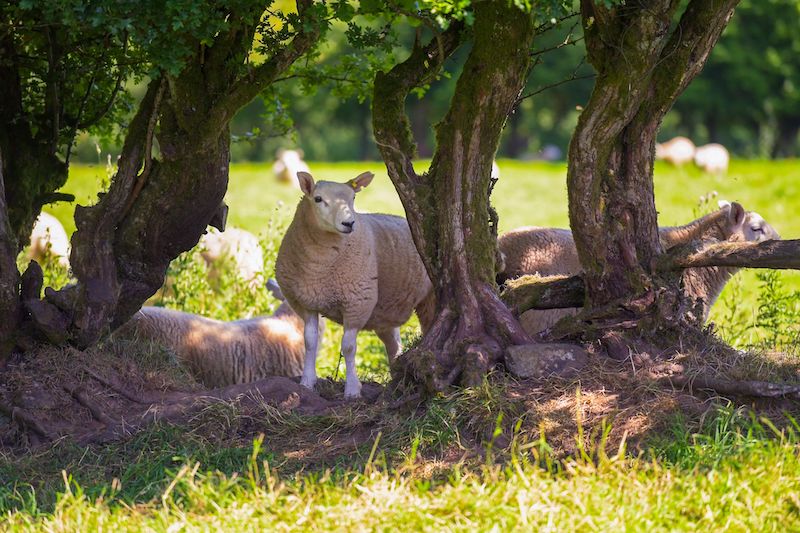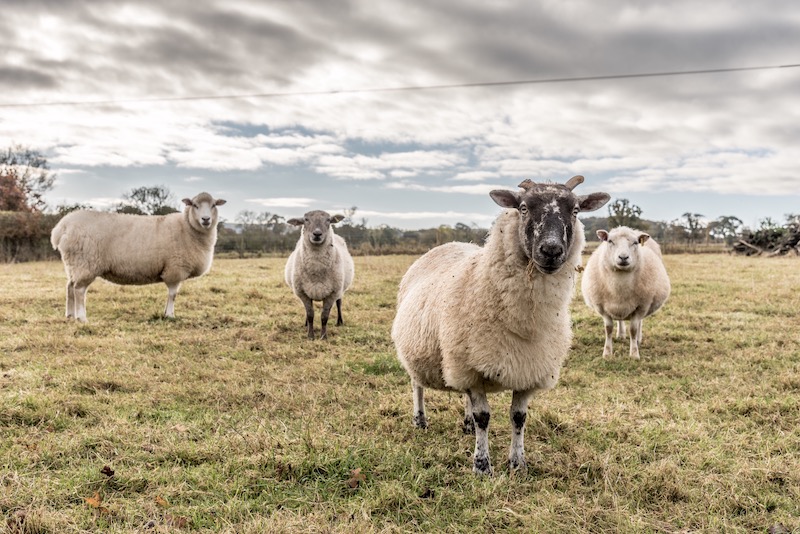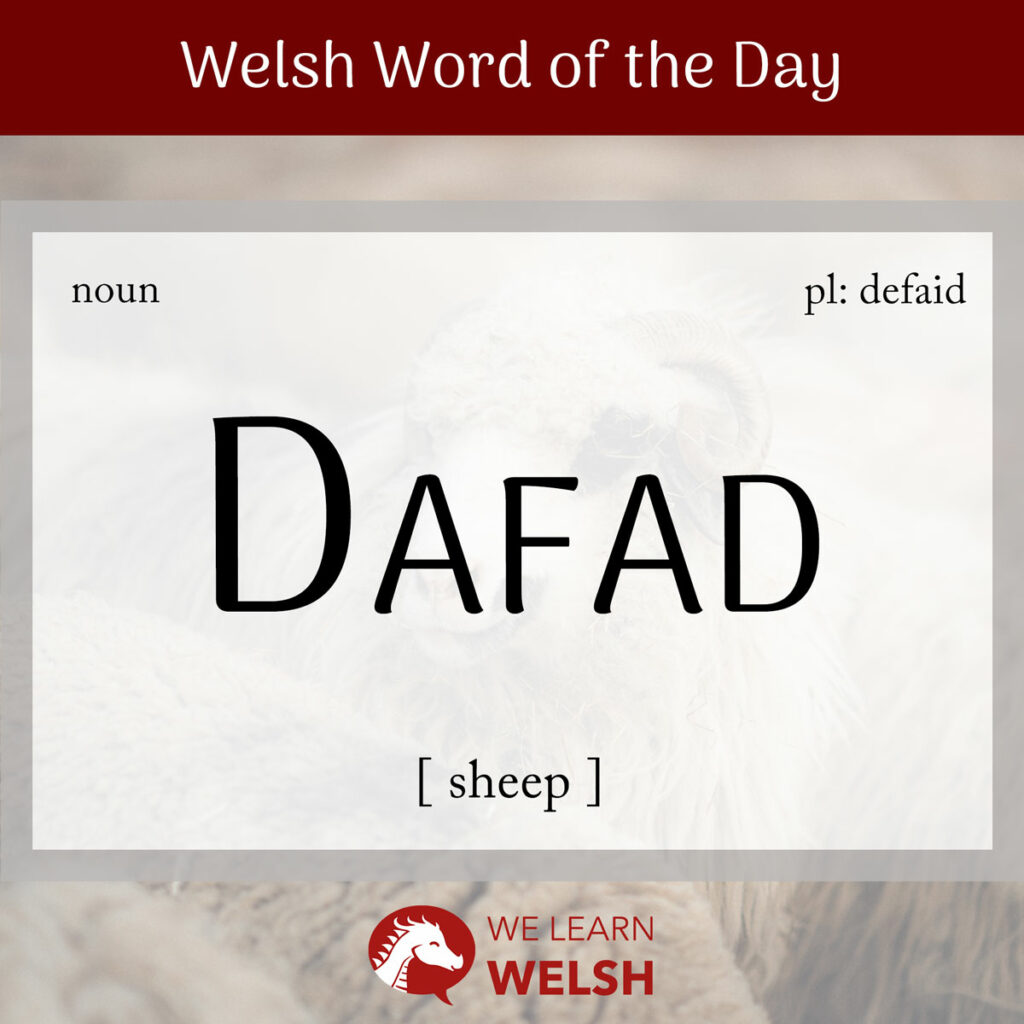Today’s word of the day is dafad, which is the Welsh word for sheep. These animals are an iconic part of the Welsh landscape, especially where I grew up in mid Wales.
dafad
sheep
Dafad, not to be confused with dafaden (wart), is a feminine noun and is susceptible to the soft and nasal mutations. For example, the soft mutation appears in y ddafad (the sheep) and the nasal mutation in fy nafad (my sheep). The most common plural of dafad is defaid, although sheep are also occasionally referred to as da wlanog (which literally translates to “woolly goods”). I could see lots of woolly defaid from my childhood bedroom window and I often fell asleep listening to brefi (bleating).
Soft mutation
ddafad
Nasal mutation
nafad
Aspirate mutation
N/A
Although of course not every Welsh person eats meat (cig) or agrees with farming practices, animal agriculture (amaeth) is an important issue in Wales and has a powerful influence on Welsh culture (diwylliant). There is evidence of Welsh sheep farming dating back to at least the 14th century, although initially sheep were farmed for their milk (llaeth/llefrith) and wool (gwlân) rather than their meat.
Welsh farmers use a variety of terms to distinguish different types of sheep. Here are some examples:
- maharen = ram (North Wales)
- hwrdd = ram (South Wales)
- mamog = ewe
- oen = lamb
- dafad swci = pet sheep
Welsh farming has changed substantially over the centuries, and many traditional practices have been lost. For example, up until the 18th century, Welsh farmers followed a seasonal system of hafod a hendre (also known as “transhumance”). In the summer (haf), farmers would take their animals up into the hills to graze on the summer grass while they stayed in a dwelling known as a hafoty. Meanwhile, down in the hendre, the main family home, crops could grow without being trampled or eaten by livestock. Once winter (gaeaf) came, the farmers would return to the sheltered lowlands with their animals. This practice was eventually made impossible by the reallocation of common land under “enclosure” laws in the late 18th and early 19th century.
Today, Welsh sheep and cattle farming is still largely carried out by small family farms, with the Welsh government classifying 59% of farms as “very small”. Agriculture is deeply embedded in the lives and identities of Welsh communities and is enabled by extensive government subsidies. Where I grew up, key annual events such as the Royal Welsh Show, which features competitions such as sheepdog trials and sheep-shearing races, dominated the calendar and breathed life into the local economy.
At the same time, Welsh farming is more intensive than ever, with farmers often draining wetlands and removing hedgerows to expand their grazing land at the expense of local wildlife. As a result, environmental conservation is a heated debate at the heart of Welsh politics, and the Welsh government continually puts new measures in place to encourage sustainable farming.

If you find yourself in a conversation about farming (as one often does in Wales!), here are some useful terms you should know:
- cig oen = lamb (meat)
- ci defaid = sheepdog
- gwlanog = woolly
- cneifio = to shear
- golchi defaid/trochi defaid = to dip sheep
- diadell o ddefaid = a herd of sheep
- yr amgylchedd = the environment
Gofalodd y bugail am ei defaid.
The shepherd looked after her sheep.
Sheep also appear in many idioms and common phrases in both Welsh and English. For example:
- blaidd mewn croen dafad = wolf in sheep’s clothing
- dafad ddu = black sheep (odd one out)
In addition, the Welsh language has some sheep-related idioms that don’t appear in English:
- mynd yn draed defaid = to go to ruin (lit. to turn into sheep’s feet)
This is similar to saying that someone “made a mess of” something or that something has “gone to the dogs”. This idiom reminds me of how muddy a field can get from being trampled by sheep’s hooves in the Welsh rain.
- defaid Gwenhidwy/defaid Dafydd Jos = ocean waves (lit. Gwenhidwy’s sheep/Davy Jones’ sheep)
Gwenhidwy is a mermaid from Welsh mythology and Davy Jones/Dafydd Jos is a common figure of nautical superstition. By referring to waves as defaid Gwenhidwy/defaid Dafydd Jos, this last idiom seems to be comparing the fluffy white coats of sheep to the white froth that appears on the tip of a breaking wave.
Dafad also appears in the following Welsh words:
- dafad y gors = night-jar (type of bird)
- cloc pen dafad = a type of old-fashioned clock (lit. sheep’s head clock)
Despite spending most of my life surrounded by sheep, in a culture shaped by sheep farming, until recently I knew surprisingly little about the animals themselves. For instance, did you know that although sheep are often thought of as stupid, they are actually intelligent and emotional animals? Defaid feel happiness (hapusrwydd), anger (dicter), surprise (syndod) and fear (ofn), which can be distinguished by watching the movement of their ears (clustiau). For example, if a sheep has one ear up and one ear down, that means they are surprised! Sheep can tell how the rest of their flock are feeling and can even tell apart human faces.
Mae gan bob dafad bersonoliaeth wahanol.
Every sheep has a different personality.
For me, the humble sheep represents both unity and conflict; farming these “woolly goods” has bound Welsh communities together for centuries, but the expansion of this same farming tradition is now threatening the vital ecosystems upon which we all rely for survival.
What do sheep mean to you? Why not take a moment to look a little more closely the next time you see one? You never know, they might recognise you!


